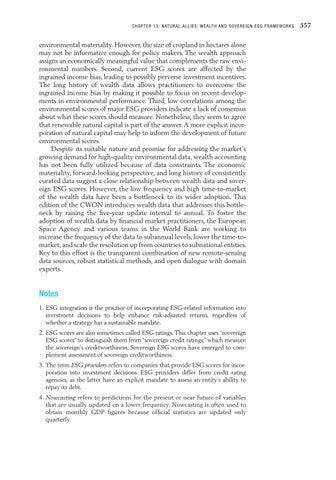CH AP TER 1 3 : N ATU R AL ALLIES: W EALTH AND SOV ER EIGN ESG FR AMEW OR KS
environmental materiality. However, the size of cropland in hectares alone may not be informative enough for policy makers. The wealth approach assigns an economically meaningful value that complements the raw environmental numbers. Second, current ESG scores are affected by the ingrained income bias, leading to possibly perverse investment incentives. The long history of wealth data allows practitioners to overcome the ingrained income bias by making it possible to focus on recent developments in environmental performance. Third, low correlations among the environmental scores of major ESG providers indicate a lack of consensus about what these scores should measure. Nonetheless, they seem to agree that renewable natural capital is part of the answer. A more explicit incorporation of natural capital may help to inform the development of future environmental scores. Despite its suitable nature and promise for addressing the market’s growing demand for high-quality environmental data, wealth accounting has not been fully utilized because of data constraints. The economic materiality, forward-looking perspective, and long history of consistently curated data suggest a close relationship between wealth data and sovereign ESG scores. However, the low frequency and high time-to-market of the wealth data have been a bottleneck to its wider adoption. This edition of the CWON introduces wealth data that addresses this bottleneck by raising the five-year update interval to annual. To foster the adoption of wealth data by financial market practitioners, the European Space Agency and various teams in the World Bank are working to increase the frequency of the data to subannual levels, lower the time-tomarket, and scale the resolution up from countries to subnational e ntities. Key to this effort is the transparent combination of new remote-sensing data sources, robust statistical methods, and open dialogue with domain experts.
Notes 1. ESG integration is the practice of incorporating ESG-related information into investment decisions to help enhance risk-adjusted returns, regardless of whether a strategy has a sustainable mandate. 2. ESG scores are also sometimes called ESG ratings. This chapter uses “sovereign ESG scores” to distinguish them from “sovereign credit ratings,” which measure the sovereign’s creditworthiness. Sovereign ESG scores have emerged to complement assessment of sovereign creditworthiness. 3. The term ESG providers refers to companies that provide ESG scores for incorporation into investment decisions. ESG providers differ from credit rating agencies, as the latter have an explicit mandate to assess an entity’s ability to repay its debt. 4. Nowcasting refers to predictions for the present or near future of variables that are usually updated on a lower frequency. Nowcasting is often used to obtain monthly GDP figures because official statistics are updated only quarterly.
357


